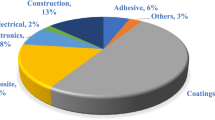Abstract
Several new epoxy monomers were synthesized from glycidylation of functional aromatic amines containing hydroxyl or thiol groups. The epoxy monomers were triglycidyl-2-aminophenol, triglycidyl-2-aminothiophenol, tetraglycidyl-1,2-phenylenediamine and tetraglycidyl-4-methyl-1,2-phenylenediamine. The characterization of the epoxy monomers was carried out by FTIR and 1H NMR spectroscopy. Rheological properties of solutions of the epoxy monomers in ethanol were evaluated using an advanced rheometer. The effect of solution concentration and temperature on the viscosity of the epoxy solution was evaluated. The shear rheology study at various temperatures of the epoxy resins solutions in ethanol was carried out on solutions with concentrations ranges form 0.5 to 5 wt% and temperatures (20–70 °C). The results revealed that the tetra-functional epoxy resins behave as Newtonian liquids and its viscosity is independent on the shear rate. However, the solutions of tri-functional epoxy resins are non-Newtonian liquids, and their viscosities are shear rate dependent. The activation energy of the epoxy monomers was calculated from the Arrhenius equation using solution with concentrations ranges of 0.5–5 wt%.







Similar content being viewed by others
References
Liu Y, Wilkinson A (2018) Rheological percolation behaviour and fracture properties of nanocomposites of MWCNTs and a highly crosslinked aerospace-grade epoxy resin system. Compos A Appl Sci Manuf 105:97–107
Brantseva TV, Ilyin SO, Gorbunova IY, Antonov SV, Korolev YM, Kerber ML (2016) Epoxy reinforcement with silicate particles: rheological and adhesive properties. Part II: characterization of composites with halloysite. Int J Adhes Adhes 68:248–255
Dayo AQ, Wang J, Wang AR, Lv D, Zegaoui A, Derradji M, Liu WB (2018) Mechanical and thermal properties of a room temperature curing epoxy resin and related hemp fibers reinforced composites using a novel in situ generated curing agent. Mater Chem Phys 203:293–301
Tao Z, Yang S, Ge Z, Chen J, Fan L (2007) Synthesis and properties of novel fluorinated epoxy resins based on 1,1-bis (4-glycidylesterphenyl)-1-(3′-trifluoromethylphenyl)-2,2,2-trifluoroethane. Eur Polym J 43(2):550–560
Atta AM, Mansour R, Abdou MI, El-Sayed AM (2005) Synthesis and characterization of tetra-functional epoxy resins from rosin. J Polym Res 12(2):127–138
Ozgul EO, Ozkul MH (2018) Effects of epoxy, hardener, and diluent types on the workability of epoxy mixtures. Constr Build Mater 158:369–377
Flint S, Markle T, Thompson S, Wallace E (2012) Bisphenol A exposure, effect and policy: a wildlife perspective. J Environ Manag 104:19–34
Niedermann P, Szebenyi G, Toldy A (2015) Novel high glass temperature sugar-based epoxy resins: characterization and comparison to mineral oil-based aliphatic and aromatic resins. Express Polym Lett 9(2):85–94
Peng YJ, He X, Wu Q, Sun PC, Wang CJ, Liu XZ (2018) An efficient way for the synthesis of epoxy resin polymers with thermoreversible cross-linking. Polyhedron. https://doi.org/10.1016/j.poly.2018.09.040
Srivastava N, Burns MA (2006) Analysis of non-Newtonian liquids using a microfluidic capillary viscometer. Anal Chem 78(5):1690–1696
Gent AN (1960) Theory of the parallel plate viscometer. Br J Appl Phys 11(2):85
Cho YI, Hartnett JP, Lee WY (1984) Non-Newtonian viscosity measurements in the intermediate shear rate range with the falling-ball viscometer. J Non-Newton Fluid Mech 15(1):61–74
Kim H, Cho YI, Lee DH, Park CM, Moon HW, Hur M et al (2013) Analytical performance evaluation of the scanning capillary tube viscometer for measurement of whole blood viscosity. Clin Biochem 46(1–2):139–142
Krieger IM (1968) Shear rate in the Couette viscometer. Trans Soc Rheol 12(1):5–11
Dagdag O, El Harfi A, Essamri A, El Gouri M, Chraibi S, Assouag M et al (2018) Phosphorous-based epoxy resin composition as an effective anticorrosive coating for steel. Int J Ind Chem. https://doi.org/10.1007/s40090-018-0152-5
Dagdag O, El Harfi A, Essamri A, El Bachiri A, Hajjaji N, Erramli H et al (2018) Anticorrosive performance of new epoxy-amine coatings based on zinc phosphate tetrahydrate as a nontoxic pigment for carbon steel in NaCl medium. Arab J Sci Eng. https://doi.org/10.1007/s13369-018-3160-z
Fetouaki S, Elharfi A, Belkebir L (2002) Synthèse d’une nouvelle résine époxyde à base du 2,2′-dihydroxydiphényle. Eur Polym J 38(4):787–793
Liu X, Shao Y, Zhang Y, Meng G, Zhang T, Wang F (2015) Using high-temperature mechanochemistry treatment to modify iron oxide and improve the corrosion performance of epoxy coating—I. High-temperature ball milling treatment. Corros Sci 90:451–462
Ollier RP, Penoff ME, Alvarez VA (2016) Microencapsulation of epoxy resins: optimization of synthesis conditions. Colloids Surf A 511:27–38
Yu Z, Di H, Ma Y, Lv L, Pan Y, Zhang C, He Y (2015) Fabrication of graphene oxide–alumina hybrids to reinforce the anti-corrosion performance of composite epoxy coatings. Appl Surf Sci 351:986–996
Liu F, Yin M, Xiong B, Zheng F, Mao W, Chen Z et al (2014) Evolution of microstructure of epoxy coating during UV degradation progress studied by slow positron annihilation spectroscopy and electrochemical impedance spectroscopy. Electrochim Acta 133:283–293
Fetouaki S, Elharfi A, Belkebir L (2002) Synthèse d’une nouvelle résine époxyde à base du 2,2′-dihydroxydiphényle. Eur Polym J 38(4):787–793
Jing C, Lei Y, Jieping Z, Sidong L, Yongjun C, Kui X (2013) Drying kinetics and cross-linking of sulfur prevulcanized thick natural rubber latex film. Rubber Chem Technol 86(1):57–67
El Hamdaoui L, El Bouchti M, El Moussaouiti M (2018) Comparison of rheological properties of kraft and microcrystalline cellulose dissolved in lithium chloride/N,N-dimethylacetamide. Polym Bull 75(2):769–779
Author information
Authors and Affiliations
Corresponding authors
Rights and permissions
About this article
Cite this article
Dagdag, O., Essamri, A., El Gana, L. et al. Synthesis, characterization and rheological properties of epoxy monomers derived from bifunctional aromatic amines. Polym. Bull. 76, 4399–4413 (2019). https://doi.org/10.1007/s00289-018-2607-4
Received:
Revised:
Accepted:
Published:
Issue Date:
DOI: https://doi.org/10.1007/s00289-018-2607-4




